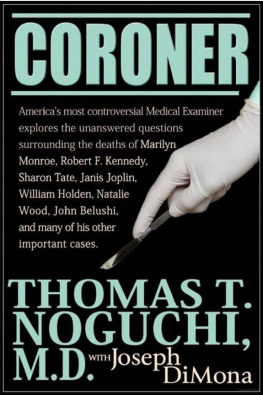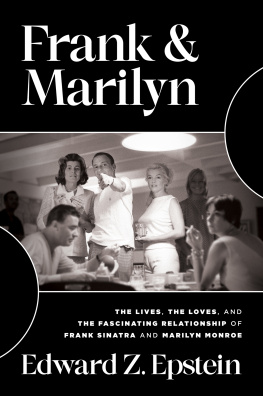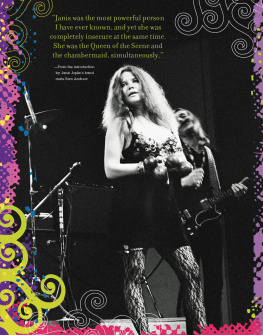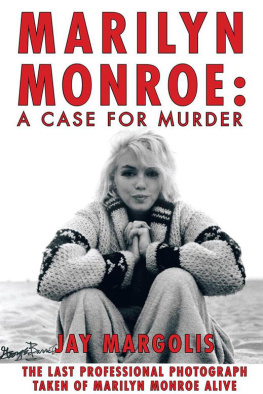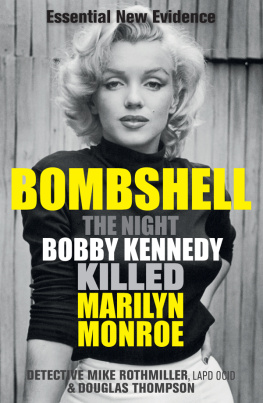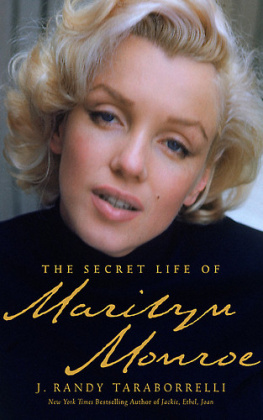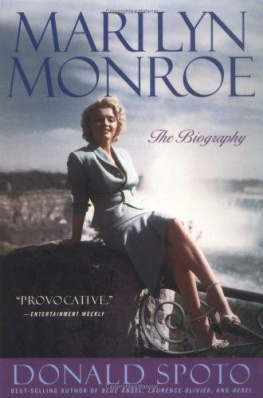Noguchi - Coroner
Here you can read online Noguchi - Coroner full text of the book (entire story) in english for free. Download pdf and epub, get meaning, cover and reviews about this ebook. year: 1983, publisher: Simon & Schuster, genre: Non-fiction. Description of the work, (preface) as well as reviews are available. Best literature library LitArk.com created for fans of good reading and offers a wide selection of genres:
Romance novel
Science fiction
Adventure
Detective
Science
History
Home and family
Prose
Art
Politics
Computer
Non-fiction
Religion
Business
Children
Humor
Choose a favorite category and find really read worthwhile books. Enjoy immersion in the world of imagination, feel the emotions of the characters or learn something new for yourself, make an fascinating discovery.
- Book:Coroner
- Author:
- Publisher:Simon & Schuster
- Genre:
- Year:1983
- Rating:3 / 5
- Favourites:Add to favourites
- Your mark:
- 60
- 1
- 2
- 3
- 4
- 5
Coroner: summary, description and annotation
We offer to read an annotation, description, summary or preface (depends on what the author of the book "Coroner" wrote himself). If you haven't found the necessary information about the book — write in the comments, we will try to find it.
Coroner — read online for free the complete book (whole text) full work
Below is the text of the book, divided by pages. System saving the place of the last page read, allows you to conveniently read the book "Coroner" online for free, without having to search again every time where you left off. Put a bookmark, and you can go to the page where you finished reading at any time.
Font size:
Interval:
Bookmark:
Also by Thomas T. Noguchi, M.D., with Joseph DiMona
Coroner at Large
C ORONER
Thomas T. Noguchi, M.D.
with
Joseph DiMona

Premier Digital Publishing - Los Angeles
Copyright 1983 by Thomas Noguchi, M.D., and Joseph DiMona
All rights reserved
ISBN 0-671-46772-7
eISBN: 978-1-937957-96-4

Premier Digital Publishing
www.PremierDigitalPublishing.com
Follow us on Twitter
Follow us on Facebook: Premier Digital Publishing
I dedicate this book
to my father, Dr. Wataru Noguchi,
and my mother, Tomika.
And to my fellow members of the
National Association of Medical Examiners.
Contents
Preface
In my memory, as I write, there is a montage of tragic scenes. The body of the beautiful Marilyn Monroe, her hand outstretched in death toward the telephone by her bed. Robert F. Kennedy, so vibrant and active in life, felled by an assassins bullet in a hotel kitchen. The grim scene at the secluded estate in Bel-Air where the pregnant Sharon Tate lay brutally massacred. The wastebasket in the hotel room where Janis Joplin met her death. The charred ruins of a little house in Los Angeles where the kidnappers of Patty Hearst perished in a hail of police bullets and a raging fire. The bizarre evidence at the scene of Albert Dekkers suicide. The luxuriousand strangely tidyapartment in which William Holden was discovered four days after he had died. The red down jacket that Natalie Wood wore when her body was found in the rain-swept waters off Catalina Island. The tiny pinpoints of blood on John Belushis arm that revealed he had not died of a heart attack.
Because my jurisdiction as Chief Medical Examiner/Coroner of the County of Los Angeles included the motion picture capital, Hollywood, my professional career has been highlighted by famous and controversial casescontroversies that persist even today. Did Marilyn Monroe commit suicide or were the drugs that killed her injected into her body by someone else? Did Sirhan Sirhan or another gunman fire the bullet which killed Robert Kennedy? Could the knives used in the murder of Sharon Tate be identified and traced to the Manson gang if they were never found? What were the real circumstances behind the drug-related death of Janis Joplin? Were the kidnappers of Patty Hearst victims of police brutality or of their own revolutionary zeal? How and why did Albert Dekker and William Holden die? How did Natalie Wood spend the last terrifying moments of her life? Was John Belushi murdered?
I conducted the forensic investigations of each of these cases. It was my job, as mandated by law, to establish the manner, cause and circumstance of death and to report my findings to the press and the public. But until now I have been unable to tell the full story behind my investigations. I am writing about them here from my own point of view as a coroner, not only to shed new light on the many troublesome questions that still remain, but to describe the techniques and goals of the little-known profession of forensic medicine itself.
In every death, there is a mystery until the cause is known. Was it natural or unnatural, a homicide, a suicide, an accident? A coroner is, if you will, a medical detective who is specifically trained to solve that mystery. He supervises the collection of evidence and interviews with witnesses at the scene. He is in charge of the autopsy on the body. And from other forensic specialists he assembles laboratory reports of the presence of minute bits of fiber or metal, the telltale traces of trauma in human tissue, and the characteristics of bone fragments, teeth, blood and body fluidsnot only to determine the cause of death, but also to establish the identity of an unknown victim and, sometimes, of the person or persons who may have murdered him. Among my other cases, my staff and I were called upon to identify the badly burned and dismembered casualties of the disastrous collision of a jet airliner and a fighter plane. In a lucky flash of intuition, I was able to determine the cause of death of a young Hollywood actress who appeared to have been shot by a nonexistent bullet. And more than once I was able to uncover evidence of murder in so-called perfect crimes.
Forensic medicine has always been a fascinating and challenging profession for me. For I believe that every coroner performs a very necessary service both for his community and for society as a whole. I also strongly believe in the independence of the coroners office as a safeguard for the people. A coroner must be gutsy. His statements and rulings may not always be popular, but he must stand firm in his conviction and tell it as it is.
In every death there are lessons to be learned for the living. Teaching those lessons and translating them into laws are the heart of the coroners work. And where death stubbornly remains a mystery, we are guided by the thought expressed in a haiku I wrote not long ago:

Medical Examiners Case No. 81-15167
Natalie Wood
S anta Catalina is an island thirty miles out in the ocean, off the southern coast of California. About twenty-two miles long and eight miles wide, it is renowned for its spectacular beauty. The spurs and canyons which radiate from its mountain ridges carve picturesque coves in which sailboats and yachts anchor beneath cliffs. Avalon, on the islands southern tip, is a small community of a few thousand year-round residents, its lovely bay known to be perfect for sailing and for scuba diving, and there are glass-bottomed boats plying the harbor, through which marine life is studied. This is the area of Catalina which most tourists know.
Yachtsmen prefer the more isolated cove at the northern end of the island. In Isthmus Bay, where the mountains swoop straight down to the sea, there are no hotels or accommodations for tourists, and only one bar/restaurant ashore, Dougs Harbor Reef, a favorite meeting place for the sailors whose boats are anchored in the cove. On the night of November 28, 1981, Natalie Wood, her husband Robert Wagner, and actor Christopher Walken, their guest on that long Thanksgiving weekend, dined at Dougs Harbor Reef and then returned to spend the night on Splendour, the Wagners yacht. In the early hours of the following morning, the body of Natalie Wood was found floating, face down, in the sea.
By a strange twist of chance, a deputy on the staff of the Los Angeles County Medical Examiners Office, our chief consultant on ocean accidents, Paul Miller, was the captain of a schooner moored to the same buoy in front of the Wagners yacht the night of the tragedy. Miller, a friend of the Wagners, was an Annapolis graduate, president of the California Sailing Academy at Marina Del Rey, one of the largest such schools in the world, and a man who knew intimately the dangerous waters around Catalina Island.
Perhaps never in my experience had the Medical Examiners Office dealt with a more perfectly positioned expert at the scene of an accident. On that terrible night, Miller dined at the same restaurant as the Wagners and Christopher Walken. After dinner, he returned to his sailing ship half an hour before the Wagners party, and was on deck when the actors passed by on their way back to Splendour. And later that night, it was he who first responded to Wagners call for assistance.
Font size:
Interval:
Bookmark:
Similar books «Coroner»
Look at similar books to Coroner. We have selected literature similar in name and meaning in the hope of providing readers with more options to find new, interesting, not yet read works.
Discussion, reviews of the book Coroner and just readers' own opinions. Leave your comments, write what you think about the work, its meaning or the main characters. Specify what exactly you liked and what you didn't like, and why you think so.

